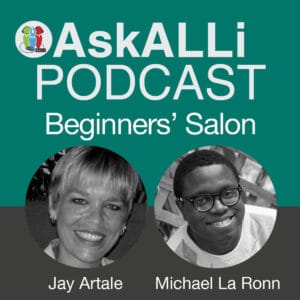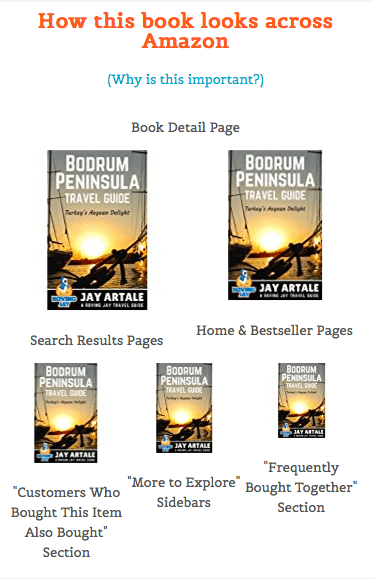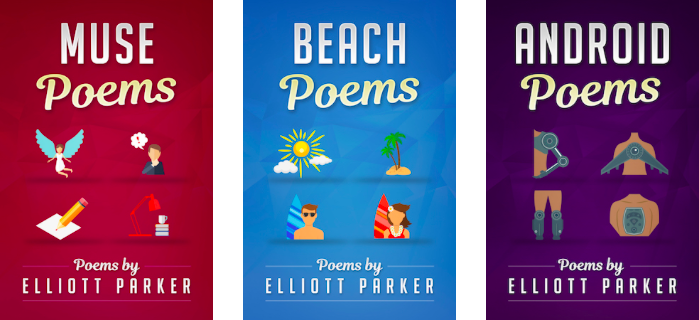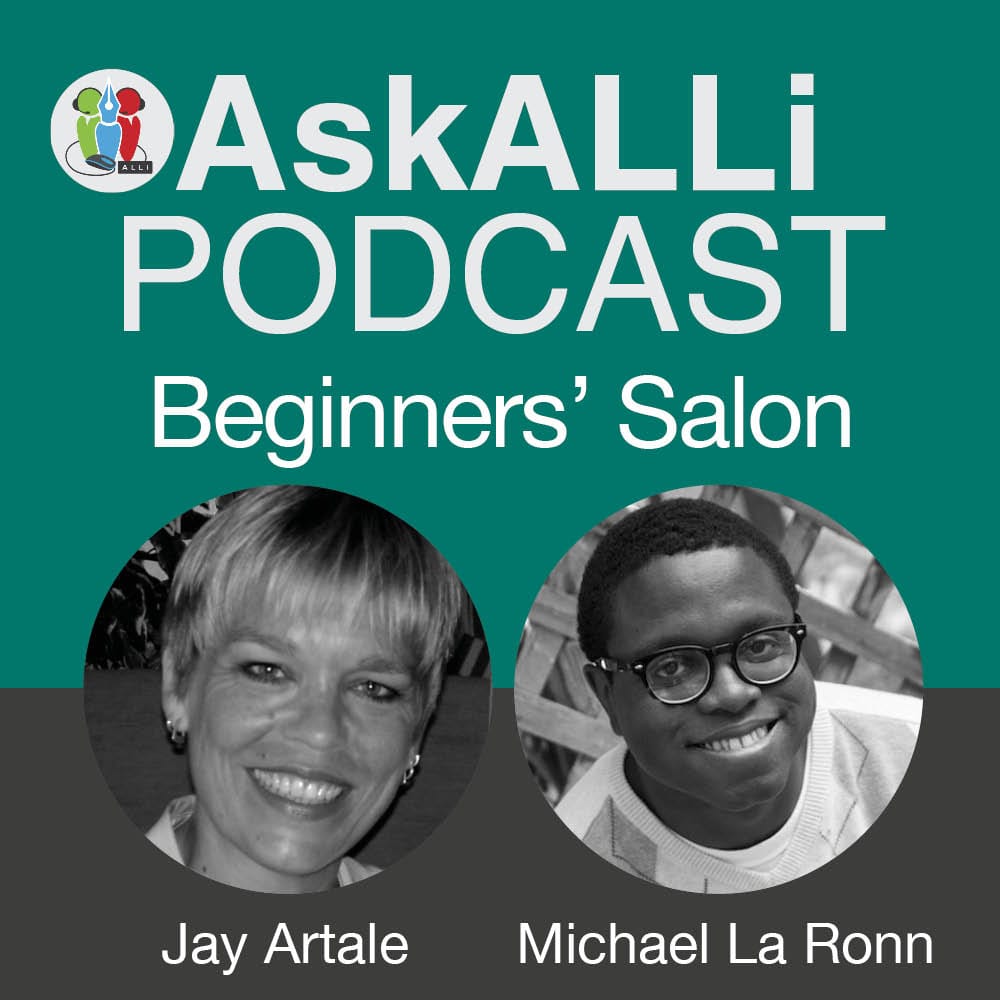
Beginners’ Self-Publishing Salon with Jay Artale & Michael La Ronn
A couple of months ago we hosted a show about eBook cover design where we discussed the different elements you should consider in the design process, your role as an author, and how to find and work with a professional cover designer.
Here at ALLi we recommend putting the most professional product out into the marketplace and part of that equation is hiring a cover designer to help you create an eye-catching cover for your ebook. But we also know that many beginning authors design their own covers, so we've recorded this podcast segment to give you tips on some design tools and advice that will help you create your own ebook cover that can tide you over until your have the budget to commission the cover of your dreams. This isn't a step-by-step guide for designing your own cover it's a summary of resources and tips to help you along your ebook cover design journey.
Here’s a summary of the topics we covered:
- eBook Design Tools
- Image Rights
- Cover Design Help
- Sourcing Stock Photos
- eBook Cover Thumbnails
Listen, Watch, or Read
Listen to our podcast, watch our broadcast, listen to the podcast, or read the transcript of the show below.
Listen to our Beginners’ Self-Publishing Salon Podcast on Soundcloud
Subscribe to our Ask ALLi podcast on iTunes, Stitcher, Soundcloud, Player.FM, Overcast, Pocket Casts, or via our RSS feed:
Watch our Beginners’ Self-Publishing Salon Broadcast on YouTube
Click here to subscribe to our YouTube Channel
Each month we’ll be discussing a different aspect of the self-publishing journey from a beginning authors perspective.
Read our Beginners’ Self-Publishing Salon Transcript
Jay: Hello, this is the beginners self-publishing podcast with me, Jay Artale and my co-host Michael La Ronn. Hello Michael.
Michael: Hey Jay, can’t believe it’s November already.
Jay: I know this year has flown by, that’s for sure. So, in September we covered eBook design and how to work with a designer. And obviously as a new author, sometimes you’ve got a limited budget.
Michael: There are probably some people who are listening to this and thinking, well, you know it’s great and all but I still can’t afford to hire a pro, how am I going to design my own cover?
Jay: And maybe it’s your first book and you don’t even know whether this, you know, being an author is what you want to do. So, you don’t want to make too much of a monitory commitment up front. Which is what I did when I did my first book, I was an author by accident, I created my first guide book and it wasn’t until I'd written my first one then I realized, I want to do this again. And you know, I didn’t spend any money with my cover design, I chose an awful font, I chose one of my photographs. I looked at Lonely Planet travel guide books and they have really simple covers which is a photograph and the title, they don’t even have an author name on the front. So, I kind of went with a lonely plant look and it works for Lonely Planet, it doesn’t work Jay Artale. But, I thought it looked fabulous and, you know, like I say, it sold. But you know, there’s lots of options if you want to design your own cover, there’s so much information out there, we live in the information age. There’s lots and lots and lots of resources out there that you can do and lots of different tools that you can use. But what would you recommend for people designing their own covers?
Michael: Yeah, and I’ll preface with this our recommendation always, if you can do it, hire someone. But if you cannot and you have to walk down this path, be sure to do it, but do it with your eyes open, just understand there are some downsides to doing this. But some tools that you can certainly use, first and foremost would be Photoshop and or InDesign, to design your own tools and if you’ve never had experience with either of those, they have quite a learning curve. There are tutorials and websites and YouTube videos and all kinds of things that you can use to get a handle on them. But if you’re not going to invest the money into a designer, you are going to have to invest the time and the money into learning the tools. If Photoshop is outside of your realm, there’s also GIMP which is a free version and it’s very similar to Photoshop and it does most of the things that Photoshop does. It’s available on Windows and McIntosh. I think it might be available on Lenox as well. And that’s a good tool that you can use. And then there’s also Canva, which is a free web based design tool that a lot of people have been using to design a lot of things. But you can also use that to design book covers.
Jay: Yeah, they have an eBook cover template so, it’s a good start there. And they have some free images that you can use and then there’s images that you can license from them. And I think that’s a key thing if you’re designing your own cover that you have the rights to use the image that you’re including on your cover so that you don’t get in any trouble and there’s lots of services out there that you can license images from.
Michael: Yup, Shutterstock, CanStock, Deposit Photo, yeah, you can just Google search and you’ll be able to find plenty of places where you can find source material.
Jay: So, they have images and one of the things that you need to do is make sure that it is licensed to use for an eBook cover because there’s lots of different licenses associated with images and whether you’re going to put it on a product that you’re going to sell versus just promotional use? So, that’s a key thing to look at when you’re trying to source image, that you have the rights to license it and use it on an eBook cover.
Michael: Right, and when in doubt ask for the permission. This is not one of those situations where you want to be slapped on the hand for forgiveness. Forgiveness in this sense is a lawsuit and all kinds of other painful things that you don’t want to have to do.
Jay: Especially if there’s a Getty image.
Michael: Exactly, a Getty image, or anyone. Yeah, you just want to be careful when you’re giving those source materials because sometimes there are some unscrupulous people out there that will say that they own the rights to an image, in fact they really don’t own it and at the end of the day if something happens it’s still your responsibility. So, that’s why using a reputable site like Shutter Stock or Deposit Photo or Can Stock, those are going to be good places because while you may pay a little bit more for the source image, you can be relatively assured that the person there has the copy right to the image that you’re buying. So, I have a couple other resources that I’d like to give people. Cover Design Secrets, that’s an eBook by Derek Murphy. He’s a great cover designer and an indie author. That’s a great little book that covers the basic design premises’ behind eBook cover design. And it also talks about the different typographies that I was mentioning earlier for different genres. So, that’s a great book to pick up if you have not read that.
The Book Cover Designer Awards, that’s Joel Friedlander, I think probably people on the show have heard of him. He’s also a great cover designer, he runs a great website that provides a lot of different resources on self-publishing. But more specifically on cover design. I don’t know if he still does this, but it’s still in the archives. It’s the awards, so, he does a monthly contest where authors can submit their covers and he critiques them and gives a gold star to the ones are the best submissions for the month and it’s a great opportunity to look at a seasoned designer looking at covers and critiquing them and talking about what works, talking about what doesn’t. And that’s a great thing for you to do for research.
Jay: Yeah, I’d liked going on there to look at, not so much what covers work or what didn’t work. Because it’s quite often it’s just a sentence and he picks out the most important thing of, you know, what doesn’t work. So, that’s really useful when you’re trying to design your own covers, understanding not only what works, but what doesn’t work. Yeah, it’s a really great resource.
Michael: And he doesn’t mince words either, that’s the best part too, I mean he’s very candid and honest about works for him and what doesn’t.
Jay: And then if you’re going to dive into Photoshop, there’s lots tutorials sites, a lot of, it’s a big learning curve with Photoshop. If you’re going to make that investment and you want to do covers and you’ve got license to use Photoshop then there’s sites like linda.com and Udemy that have courses that you can subscribe to and pay for doing basics of cover design. So, I haven’t done any cover design courses on Udemy but I’ve done some other courses and I really their format because there’s usually really short videos covering specific topics and it will work you through the whole process.
Michael: And it’s very affordable and they run sales all the time. You can get a good price for a lot of these tutorials and if that doesn’t work for you and if you can’t find anything there go to YouTube. There’s hours and hours of video instructions on Photoshop and composition and color theory and all those sorts of things about cover designs that you can find on YouTube. You will have to do a little bit of work to find them and you will have to filter through some of the stuff that might not be relevant to you but that is also a good place that you can start. And then the last resource that I would offer up to people is your local library. So, when I was starting off as an author I went and rented out a lot of color design books, a lot of art books and pattern design books and things like that just to look through them and get inspired. That’s something that you can do as well, to help keep you fresh and find out what kind of design schools and design theories there are that can be helpful to you as well.
Jay: Yeah, there are lots of websites out there. And I like the websites that show you complementary colors. So, if you’re fixated on a certain color or you’re using a background image with a specific color, looking at using these color wheel sites that shows you the complimentary colors that would work well with that cover.

Author Marketing Club offers a free Bookalyzer Tool for viewing Amazon Thumbnails
Jay: Going back to an earlier comment we made, what does your cover looks like on a thumbnail. Making so many covers that I see, once they’re small you can’t really make out the title or you definitely can’t make out the author name because it’s so small. So, you know, if they’re a key part of your cover design and the title surely is, then it needs to stand out when it’s at that thumbnail size. But there are lots of resources available and there’s so many different elements which if you look at the amount to time that you’re going to spend researching all of those core elements, what to bring to your book and everything, balance out with what you’re going to pay a cover designer. At the end of the day, you know, you’ve got to look at what’s the value of your time and, you know.
Michael: I would say your time is more expensive and valuable then money. There’s some video resources on the self-publishing site by Paul Teague right that …
Jay: Oh yeah, on our home page, our book design advice home page, Paul’s done a series of really short videos on, you know, working with a designer, if you’re going to do it yourselves, if you’re going to use a template service. So, he goes through each one and each video covers basically all the same things that we talked about today and it really breaks the process down into the decisions you’ve got to make. And looks at the process and how complex it is. And he hasn’t mentioned price but he does rate them on, you know, cheaper versus medium versus more expensive.
Michael: Yeah, that’s a great resource for people to look at, especially if you have some time and if you want to do your own covers. You’ll definitely, whether you do or not, you still want to look at it and find out what you can glean from it.
Jay: Yes. So, any other pearls of wisdom based on your cover design experience that you want to bring to the table before we wrap up todays show?
Michael: I would just say it’s a journey. Don’t expect that your very first cover, whether you hire them or do them yourself, that they’ll necessarily be amazing because you’ll learn more about book covers as you go. I feel like I know a lot more then I knew back in 2014 when I first started. And so, just like your author careers a journey, your knowledge of covers and what constitutes a good cover is a journey and also remember that cover tastes change. And so, what’s hot in urban fantasy covers now is not necessarily going to be hot in urban fantasy covers in five years from now. So, just know you’ll always have to stay on top of what’s current in your genre and that you’ll have to be prepared to pivot when you need to.
Jay: So, you’re writing, starting to write in a new genre now aren’t you?
Michael: Yeah.
Jay: So, how are you approaching that one with your cover design, have you even thought about cover design yet?
Michael: Oh yeah, yeah I’ve actually already hired the designer and I should have those covers next month. But yeah, I just did a lot of the research topics and tips that we talked about in this show, so, going to Pinterest, looking at the top books on Amazon, yeah, just looking at all that.
Jay: How do you handle that for a newish niche, is there still books out there in that niche?
Michael: There are, there aren’t as many and so that’s why like I’ve said before, you have to figure out what that one thing is. So, if this is a book about a video game, what is it that you’re going to put on the cover that makes it look like a video game? And so, that’s kind of been my guiding thing. If you can just still that down to one or two elements, that’s going to serve you well especially when you have a genre like Lit RPG, where there really aren’t that many, I mean there are, but there’s no established standards yet and so, you kind have to look at all of them, figure what’s that one thing they all have in common at a very high level and then go from there. So, it’s a little bit of a challenge but its fun.
Jay: It’s a bit like designing a poetry book cover.
Michael: Yeah, pretty much. It’s exactly the same, exactly the same. Except with poetry you really don’t have a one guiding principle that you can put on the cover because it’s all so different.
Jay: You’ve got poetry books out there haven’t you?
Michael: I do, I do I have three poetry collections and what I decided to was to just come up with a design and maybe I can put a covers on the show notes as well, to have just a core design that I can put on all of my different covers.

So, I basically do like four illustrated images. So, like for my beach poem collection I have a beach ball, I’ve got two guys with sun glasses, I’ve got a surf board and then a palm tree. That’s just on the cover. But then on my next collection which is like my android collection I’ve got four android parts, and so, it’s like four corners. So, if you look at them all it’s all got consistent branding, consistent color schemes, my author name looks the same and so I just made a decision that, that’s what I want my poetry collections to look like moving forward. Yeah, there’s no wrong or right answer, I guess you just know if the book is selling or not right?
Jay: Whether it’s selling and, you know, you were saying that the market’s taste change but I think you as an author, your taste change as well don’t they as you understand more about it, you realize that, oh my goodness, I can’t believe that I’ve got a cover out there that looks like that, I need to change it. I did my first print book the other month and, you know, you really have got to start looking at things differently when you’re doing print. So, you know, we’re going to do a show about print book covers somewhere down the line because, you know, obviously you’ve got a back cover that you have to do and there’s more elements to look at. So, it think that deserves a show by itself but as far as eBook covers, you know, looking at what your role is as an author, knowing what works, what doesn’t work, understanding your genre and knowing, being able in envision what your image is going to look like in a small thumbnail, I think are some of the key elements, as long you’ve always got those in the back of your mind whether you’re working with a designer or doing things yourself. Those are the key things that you’ve got to carry forward.
Michael: Definitely. So, what are you going to be working on for the next month?
Jay: I’ve got my four book series of How to Write a Travel Guide and the first book in the series is the planning process behind writing a travel guide. So, I’ve actually put it on Amazon for pre-sale to motivate me to finish it. So, these books, this four series have been languishing for about a year and a half now and I really just need to get the first one out there.
Jay: So, on our self-publishing advice blog, if you go to our book design advice home page, you will find a series of videos by Paul Teague. They’re short videos and they cover the same topics that we covered today but just from a different slant. So, that’s a great resource and also that homepage is a good resource for articles about working with a cover designer. There’s a blog post about five tips for designing your own cover. So, there’s a wealth of information. So, even though we do recommend that you have a designer design your eBook cover, lots of information on the website about designing your own eBook cover.
So, that’s it for this month’s show, you can drop us a comment on the show summary page at www.selfpublishingadvice.org. So, as always if you enjoyed this episode, we encourage you to leave a review on your podcast network of choice as this really helps us find more great listeners like you and it also helps the other shows on our network. Thanks for listening and we’ll see you next month, happy writing.
Here's some helpful book cover design tips for beginners. Share on X
Meet your AskALLi Podcast Show Hosts

Jay Artale is a project manager who swapped corporate life for a nomadic existence as a non-fiction writer. She’s the author of travel and travel writing guides, and poetry collections.
Jay is also one of the co-organizers of the Indie Author Fringe, a 3X a year online conference for indie authors who self-publish.
Connect on Twitter: @BirdsOAFPress

Michael La Ronn is the author of over 30 science fiction & fantasy novels and author self-help books. To date, he has published over 1.5 million words of fiction and nonfiction. Since publishing his first book in 2014, he has produced a prolific writing portfolio while raising a family and working a full-time job in the insurance industry.
Connect on Twitter: @MichaelLaRonn
Where can I watch or listen to more Ask ALLi?
- You can catch up on all of our videos on ALLi’s YouTube Channel
- You can listen to all of our podcast recordings at ALLi’s SoundCloud Channel
Interested in joining ALLi? Besides being able to submit questions to this monthly Q&A, there are lots of other benefits of being an ALLi member. Click this banner to find out more.






